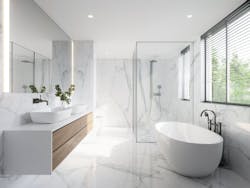Constructing homes with universal design principles can give builders a leg up on the competition. Universal design expands a home’s livability to all people, limits the need for renovations in the future, and the concept can support aging in place. Between now and 2060, the number of older adults in the U.S. is expected to increase by 69%, says the National Association of Home Builders. Many accessibility features in the NAHB’s What Home Buyers Really Want 2021 survey were deemed essential or desirable by surveyed homeowners such as a full bath on the main level, doorways at least 3 feet wide, and hallways at least 4 feet wide.
Their desire for these features has been increasing since surveys began in 2003. (For example, the desire for an entrance without steps has increased from 42% to 64%.)
The survey also found that the older the buyer, the more likely they wanted these features. But even the majority of younger buyers (less than 35 years of age) rated them as essential or desirable. This indicates that accessibility features will generally add value to a home for most home buyers.
The 2020 ICC 700 National Green Building Standard® (NGBS) UNIVERSAL DESIGN badge supports the concept of aging in place and provides an independent third-party verification that a home is designed and constructed for all.
Check out the first home to achieve this badge — “The Gladstone” of Urban Downs in Richfield, Wash. — during the July 15 Home Performance Counts: Virtual Green Home Tour Series. The home is certified to 2020 NGBS Green Emerald-level certification and also earned the NGBS Green+ WELLNESS badge.
